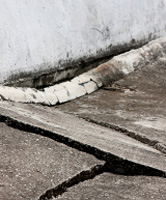Liability for Subsidence caused by Tree Roots
 The Judgement in Khan and Khan v London Borough of Harrow and Kane [2013] EWHC 2687 (TCC) considers when a landowner will be liable for subsidence caused by trees on their property, and to what extent the risk of that subsidence must be foreseeable.
The Judgement in Khan and Khan v London Borough of Harrow and Kane [2013] EWHC 2687 (TCC) considers when a landowner will be liable for subsidence caused by trees on their property, and to what extent the risk of that subsidence must be foreseeable.
Summary
The Judge in this case agreed with the Defendant that the general risk of tree root subsidence is not sufficient to make all damage reasonably foreseeable, otherwise every claim due to subsidence would succeed. Rather, a tree's position, height or condition, the type of soil, or a combination of these factors would need to indicate the risk of subsidence in a particular case. Mrs Kane was liable for the damage caused by the Cypress hedge, but not by the oak tree, largely due to its size and proximity to the Khans' house.
Facts
The case concerned an oak tree and a Cypress hedge, both of which were in the garden of Mrs Kane, and both of which caused damage to Mr and Mrs Khan's property next door. The Cypress hedge was very close to the Khans' property, dominating one side of their house, whereas the oak tree was further away, in the corner of Mrs Kane's garden.
Issues
The Khans brought a claim for nuisance against Mrs Kane, arguing the she was liable for the damage to their property as she had failed to act, despite the damage being reasonably foreseeable by a reasonably prudent landowner. Mrs Kane argued that she was not liable since she did not, in fact, foresee the risk of damage, and that she should not be held to the higher standard of a reasonably prudent landowner.
Judgment
In his judgment, Mr Justice Ramsey agreed with both parties in part. On the legal question regarding the relevant standard, he agreed with the Khans that the law expects landowners to foresee subsidence damage that would be reasonably foreseen by a reasonably prudent landowner.
The judge did not agree that Mrs Kane's lack of actual knowledge about the risk of subsidence could lower this standard, although such knowledge might raise it (i.e. it may be reasonable for a more informed landowner to foresee damage in more circumstances than they would otherwise). Therefore, the test "creates a floor but not a ceiling on the level of knowledge" (at paragraph 42).
Significance
Khan and Khan has double significance, both clarifying the law and its practical application. Legally, the decision has reaffirmed the court's position on reasonable foreseeability. Following the ABI Domestic Tree Root Agreement, British insurers have not pursued subsidence claims unless the landowner was aware of the risk and failed to take preventative action. This has given rise to the misconception that actual knowledge of the risk is a requirement for liability. The judgment in Khan and Khan corrects this misconception. Rather, the test is an objective one: would a reasonably prudent landowner have foreseen the risk of subsidence damage? If yes, then the landowner may be liable even if they did not themselves foresee that risk.
The practical significance is that landowners now know they must be vigilant in noting any factors that might indicate subsidence, including the position, height and condition of their trees or other vegetation. In addition, the type of soil is a relevant factor, with the judge finding that "a reasonably prudent landowner with trees on their land ought, in the period leading up to 2006, to have been aware that there is a risk of subsidence damage to property caused by tree roots, particularly on clay sub-soils" (at paragraph 48).
If you would like advice regarding tree root subsidence or other property disputes, please contact Charlotte Waters at waters@fsw-law.com or telephone 0207 993 6960.